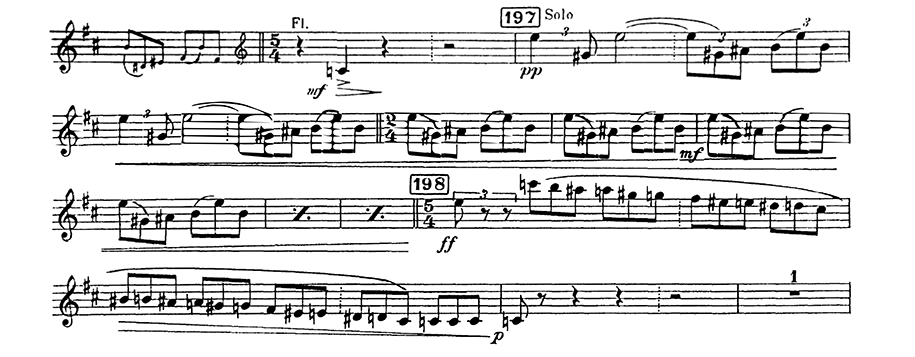Maurice Ravel (1875-1937) started writing Daphnis et Chloé, his ballet in three scenes, in 1909, and it was premiered in 1912.
This ballet, and its suites, which are more often performed, are a treat for flutists.
All four flute parts in this piece (piccolo, first and second flutes, and alto flute) are important audition pieces. One of its most beautiful moments is the alto flute solo, which is often asked for in Associate Principal auditions.
2 measures before #188 to #189

The solo starts with a descending scale, which is the continuation of the scale first started by the piccolo, then continued by the first and second flutes and finished by the alto flute. The scale and the subsequent eighth notes are awkward since the pinky has to slide from D#1 to C#1 to B#1, and then ascend on the same notes. Practice the pinky movement by itself, and make sure to have the tip of your pinky well oiled by rubbing it against the side of your nose.
As an alternative, you can put a rubber band on the C# key (the key itself, not the part where your pinky touches the lever to the key), which ensures that the C# will close properly and make the transition from D#1 to C#1 and to B#1 easier. I don't use this option since it makes E1 and D#1 sound weaker and somewhat flat, but you should try it. [pictured below on a concert flute]

Many flute players, including me, take a breath after the fermata on G#1. If you want to avoid that breath (or your conductor doesn't want to hear a breath between the G#s), you can take a quick breath or circular breathe on the 3rd beat of 2 measures after #188. Your breath will be concealed by the trills on the piccolo and 2 flutes.
#197 to 2 measures after #198

One of the tricky things about the solo above is that the E2 tends to speak slowly, thus sounding a little late. Also, on some alto flutes that note sounds like a harmonic. To remedy that you can try the fingerings below.
E2 
E2 
E2
The 2 fingerings that use the second trill key tend to be a little too sharp. If you can, depress just slightly the second trill key. Otherwise, to lower the pitch use one of the following 3 methods: 1. press the lip plate more against your lower lip, 2. aim your upper lip down towards the embouchure hole, 3. roll your flute inwards.
NOTE: If you don't have an alto flute, practice the part on your regular flute. The transition to alto flute is not that hard, and you'll enjoy playing this beautiful music.
